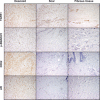Signal transduction pathway analysis in desmoid-type fibromatosis: transforming growth factor-β, COX2 and sex steroid receptors
- PMID: 23035734
- PMCID: PMC4278584
- DOI: 10.1111/cas.12037
Signal transduction pathway analysis in desmoid-type fibromatosis: transforming growth factor-β, COX2 and sex steroid receptors
Abstract
Despite reports of sex steroid receptor and COX2 expression in desmoid-type fibromatosis, responses to single agent therapy with anti-estrogens and non-steroidal anti-inflammatory drugs are unpredictable. Perhaps combination pharmacotherapy might be more effective in desmoid tumors that co-express these targets. Clearly, further understanding of the signaling pathways deregulated in desmoid tumors is essential for the development of targeted molecular therapy. Transforming growth factor-β (TGFβ) and bone morphogenetic proteins (BMP) are important regulators of fibroblast proliferation and matrix deposition, but little is known about the TGFβ superfamily in fibromatosis. A tissue microarray representing 27 desmoid tumors was constructed; 14 samples of healing scar and six samples of normal fibrous tissue were included for comparison. Expression of selected receptors and activated downstream transcription factors of TGFβ family signaling pathways, β-catenin, sex steroid hormone receptors and COX2 were assessed using immunohistochemistry; patterns of co-expression were explored via correlational statistical analyses. In addition to β-catenin, immunoreactivity for phosphorylated SMAD2/3 (indicative of active TGFβ signaling) and COX2 was significantly increased in desmoid tumors compared with healing scar and quiescent fibrous tissue. Low levels of phosphorylated SMAD1/5/8 were detected in only a minority of cases. Transforming growth factor-β receptor type 1 and androgen receptor were expressed in both desmoid tumors and scar, but not in fibrous tissue. Estrogen receptor-β was present in all cases studied. Transforming growth factor-β signaling appears to be activated in desmoid-type fibromatosis and phosphorylated SMAD2/3 and COX2 immunoreactivity might be of diagnostic utility in these tumors. Given the frequency of androgen receptor, estrogen receptor-β and COX2 co-expression in desmoid tumors, further assessment of the efficacy of combination pharmacotherapy using hormonal agonists/antagonists together with COX2 inhibitors should be considered.
© 2012 Japanese Cancer Association.
Figures



Similar articles
-
TGF-β and CTGF are Mitogenic Output Mediators of Wnt/β-Catenin Signaling in Desmoid Fibromatosis.Appl Immunohistochem Mol Morphol. 2017 Sep;25(8):559-565. doi: 10.1097/PAI.0000000000000340. Appl Immunohistochem Mol Morphol. 2017. PMID: 26894649
-
Signal transduction pathway analysis in fibromatosis: receptor and nonreceptor tyrosine kinases.Hum Pathol. 2012 Oct;43(10):1711-8. doi: 10.1016/j.humpath.2011.12.021. Epub 2012 Apr 18. Hum Pathol. 2012. PMID: 22520949 Free PMC article.
-
Molecular Pathogenesis of Sporadic Desmoid Tumours and Its Implications for Novel Therapies: A Systematised Narrative Review.Target Oncol. 2022 May;17(3):223-252. doi: 10.1007/s11523-022-00876-z. Epub 2022 Apr 21. Target Oncol. 2022. PMID: 35446005 Free PMC article. Review.
-
Expression profiles of sex steroid receptors in desmoid tumors.Tohoku J Exp Med. 2006 Nov;210(3):189-98. doi: 10.1620/tjem.210.189. Tohoku J Exp Med. 2006. PMID: 17077595
-
Bone morphogenetic proteins.Growth Factors. 2004 Dec;22(4):233-41. doi: 10.1080/08977190412331279890. Growth Factors. 2004. PMID: 15621726 Review.
Cited by
-
Current Treatment Concepts for Extra-Abdominal Desmoid-Type Fibromatosis: A Narrative Review.Cancers (Basel). 2024 Jan 8;16(2):273. doi: 10.3390/cancers16020273. Cancers (Basel). 2024. PMID: 38254764 Free PMC article. Review.
-
The Wnt/β-catenin pathway in human fibrotic-like diseases and its eligibility as a therapeutic target.Mol Cell Ther. 2015 Jan 30;3:1. doi: 10.1186/s40591-015-0038-2. eCollection 2015. Mol Cell Ther. 2015. PMID: 26056602 Free PMC article.
-
Fibromatosis - immunohistochemical evaluation, differential diagnosis from gastrointestinal tumors, and other mesenchymal tumours.Prz Gastroenterol. 2019;14(1):79-85. doi: 10.5114/pg.2019.83429. Epub 2019 Mar 12. Prz Gastroenterol. 2019. PMID: 30944681 Free PMC article.
-
Management of Desmoid Disease in Familial Adenomatous Polyposis.Clin Colon Rectal Surg. 2023 Jul 25;37(3):185-190. doi: 10.1055/s-0043-1770731. eCollection 2024 May. Clin Colon Rectal Surg. 2023. PMID: 38606047 Free PMC article. Review.
-
Evolving strategies for management of desmoid tumor.Cancer. 2022 Aug 15;128(16):3027-3040. doi: 10.1002/cncr.34332. Epub 2022 Jun 7. Cancer. 2022. PMID: 35670122 Free PMC article. Review.
References
-
- Francis WP, Zippel D, Mack LA et al Desmoids: a revelation in biology and treatment. Ann Surg Oncol 2009; 16: 1650–4. - PubMed
-
- De Bree E, Keus R, Melissas J, Tsiftsis D, Van Coevorden F. Desmoid tumors: need for an individualized approach. Expert Rev Anticancer Ther 2009; 9: 525–35. - PubMed
-
- Stoeckle E, Coindre JM, Longy M et al A critical analysis of treatment strategies in desmoid tumours: a review of a series of 106 cases. Eur J Surg Oncol 2009; 35: 129–34. - PubMed
-
- Gluck I, Griffith KA, Biermann JS, Feng FY, Lucas DR, Ben‐Josef E. Role of radiotherapy in the management of desmoid tumors. Int J Radiat Oncol Biol Phys 2011; 80: 787–92. - PubMed
Publication types
MeSH terms
Substances
Grants and funding
LinkOut - more resources
Full Text Sources
Research Materials

